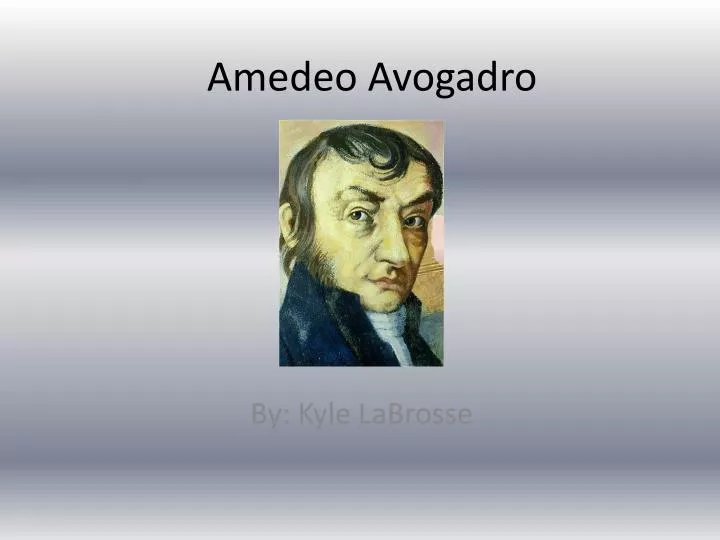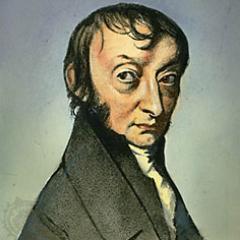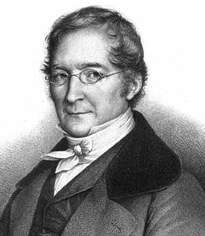- Amedeo Avogadro inherited the title of Count from his father. In fact, Amedeo Avogadro’s full name was Count Lorenzo Romano Amedeo Carlo Avogadro di Quaregna e di Cerreto – quite a mouthful! Avogadro was highly intelligent. In 1796, when he was only 20, he was awarded a doctorate in canon law and began to practice as an ecclesiastical lawyer.
- Amadeo Avogadro was an Italian scientist noted to be one of the founders of physical chemistry. He was actually a physics professor but he experimented in both physics and chemistry using mathematics to base most of his findings. Avogadro is well known for his hypothesis known as Avogadro's Law.
Lorenzo Romano Amedeo Carlo Avogadro, Conte di Quaregna e Cerreto (. 9. August 1776 in Turin; † 9. Juli 1856 ebenda) war ein italienischer Physiker und Chemiker. Amedeo Avogadro was born in Turin to a noble family of the Kingdom of Sardinia (now part of Italy) in the year 1776. He graduated in ecclesiastical law at the late age of 20 and began to practice. Soon after, he dedicated himself to physics and mathematics (then called positive philosophy ), 6 and in 1809 started teaching them at a liceo.
Learning Objective
- Define and memorize Avogadro’s number

Key Points

- The mole allows scientists to calculate the number of elementary entities (usually atoms or molecules) in a certain mass of a given substance.
- Avogadro’s number is an absolute number: there are 6.022×1023 elementary entities in 1 mole. This can also be written as 6.022×1023 mol-1.
- The mass of one mole of a substance is equal to that substance’s molecular weight. For example, the mean molecular weight of water is 18.015 atomic mass units (amu), so one mole of water weight 18.015 grams.
Term
- moleThe amount of substance of a system that contains as many elementary entities as there are atoms in 12 g of carbon-12.
The chemical changes observed in any reaction involve the rearrangement of billions of atoms. It is impractical to try to count or visualize all these atoms, but scientists need some way to refer to the entire quantity. They also need a way to compare these numbers and relate them to the weights of the substances, which they can measure and observe. The solution is the concept of the mole, which is very important in quantitative chemistry.
Avogadro’s Number
Amadeo Avogadro first proposed that the volume of a gas at a given pressure and temperature is proportional to the number of atoms or molecules, regardless of the type of gas. Although he did not determine the exact proportion, he is credited for the idea.
Avogadro’s number is a proportion that relates molar mass on an atomic scale to physical mass on a human scale. Avogadro’s number is defined as the number of elementary particles (molecules, atoms, compounds, etc.) per mole of a substance. It is equal to 6.022×1023 mol-1 and is expressed as the symbol NA.

Avogadro’s number is a similar concept to that of a dozen or a gross. A dozen molecules is 12 molecules. A gross of molecules is 144 molecules. Avogadro’s number is 6.022×1023 molecules. With Avogadro’s number, scientists can discuss and compare very large numbers, which is useful because substances in everyday quantities contain very large numbers of atoms and molecules.

The Mole
The mole (abbreviated mol) is the SI measure of quantity of a “chemical entity,” such as atoms, electrons, or protons. It is defined as the amount of a substance that contains as many particles as there are atoms in 12 grams of pure carbon-12. So, 1 mol contains 6.022×1023 elementary entities of the substance.
Amedeo Avogadro Biografia Corta
Chemical Computations with Avogadro’s Number and the Mole
Avogadro’s number is fundamental to understanding both the makeup of molecules and their interactions and combinations. For example, since one atom of oxygen will combine with two atoms of hydrogen to create one molecule of water (H2O), one mole of oxygen (6.022×1023 of O atoms) will combine with two moles of hydrogen (2 × 6.022×1023 of H atoms) to make one mole of H2O.
Another property of Avogadro’s number is that the mass of one mole of a substance is equal to that substance’s molecular weight. For example, the mean molecular weight of water is 18.015 atomic mass units (amu), so one mole of water weight 18.015 grams. This property simplifies many chemical computations.
If you have 1.25 grams of a molecule with molecular weight of 134.1 g/mol, how many moles of that molecule do you have?
[latex]1.25g times frac{ 1 text{ mole}}{134.1g}=0.0093 text{ moles}.[/latex]
Show SourcesBoundless vets and curates high-quality, openly licensed content from around the Internet. This particular resource used the following sources:
http://www.boundless.com/
Boundless Learning
CC BY-SA 3.0.
http://www.chem1.com/acad/webtext/intro/int-2.html#SEC2
Steve Lower’s Website
CC BY-SA.
http://en.wiktionary.org/wiki/mole
Wiktionary
CC BY-SA 3.0.
Avogadro Amedeo &
http://en.wikipedia.org/wiki/Mole_(unit)
Wikipedia
CC BY-SA 3.0.

http://en.wikipedia.org/wiki/Avogadro_constant
Wikipedia
CC BY-SA 3.0.
http://en.wikipedia.org/wiki/Avogadro_constant%23mediaviewer/File:Avogadro_Amedeo.jpg
Wikimedia
Public domain.
Lorenzo Romano Amedeo Carlo Avogadro (August 9, 1776 to July 9, 1856) Avogadro is famous for Avogadro’s Law, which states that two gases of equal volume at the same temperature and pressure contain an equal number of molecules. In honor of him, the number of molecules in a mole of a substance is called Avogadro’s number. Avogadro, who was of noble birth, obtained a degree in ecclesiastical law and started practice in that field, before deciding to pursue a scientific career. At that time, the existence of atoms and molecules was still hypothetical and very controversial. Experiments of Joseph Gay-Lussac had shown that gases reacted in simple integer ratios of volumes. For example, when two liters of hydrogen gas reacted with one liter of oxygen gas two liters of water vapor were produced. Avogadro correctly interpreted these results in terms of his hypothesis that equal volumes of gas contain equal numbers of molecules. For example, the reaction of hydrogen and oxygen can be understood, if hydrogen and oxygen molecules are diatomic, as resulting from this molecular reaction: 2H2 + O2 → 2 H2O. Avogadro’s work was largely ignored during his lifetime but became known shortly after his death and eventually his ideas were shown to be correct. Little is known about Avogadro’s private life, but his obituary in the Gazzetta Piemontese nine days after his death says that he was “religioso senza intolleranza, dotto senza pedanteria” (“religious without intolerance, learned without pedantry”).
